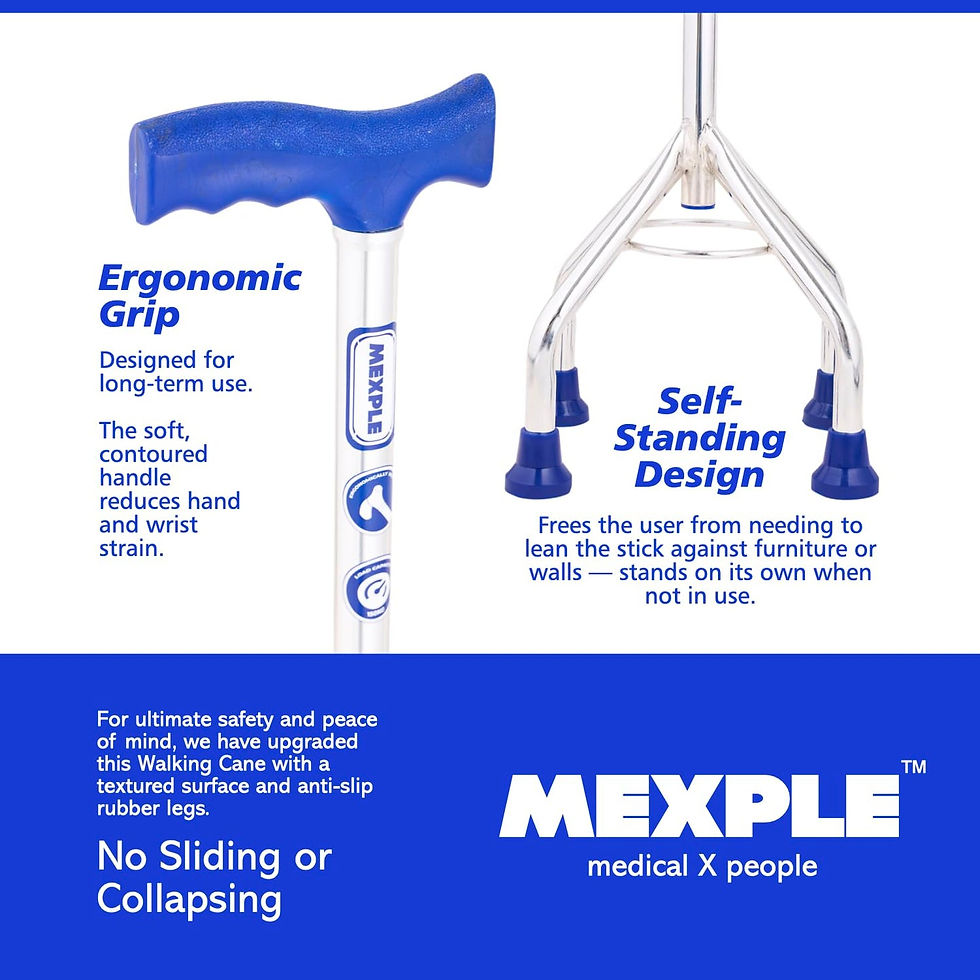Walking Stick vs. Cane: What’s the Difference and Which One Should You Choose?
- mexple11
- 16 minutes ago
- 4 min read
Mobility aids play a crucial role in maintaining independence and stability for people with balance issues, injuries, or age-related mobility challenges. Among the most common aids are walking sticks and canes — two tools that seem similar but serve different purposes.
Choosing between them depends on your specific needs, level of mobility, and comfort preferences. In this article, we’ll explore the key differences between walking sticks and canes, their functions, and how to decide which one is right for you.

1. Understanding Walking Sticks
A walking stick is primarily designed for support and balance during walking or hiking. It is often used by people who do not necessarily have mobility limitations but prefer additional stability on uneven or outdoor surfaces.
Key Features of a Walking Stick:
Single point of contact: Most walking sticks have a single tip at the bottom.
Lightweight design: Usually crafted from wood, aluminum, or carbon fiber.
Ergonomic handle: Often designed for comfort during long walks.
Adjustable height: Modern walking sticks come with adjustable height options for customized use.
Stylish and functional: Many walking sticks double as fashion accessories or trekking gear.
Ideal for:
Individuals who need occasional balance support.
Outdoor enthusiasts and hikers navigating uneven terrain.
People with mild mobility issues or recovering from minor injuries.
Walking sticks are excellent for general use but do not provide significant weight-bearing support.
2. Understanding Canes
A cane, on the other hand, is a medical mobility aid designed to help people who need consistent support due to injury, surgery, or chronic conditions such as arthritis or neurological disorders. It is sturdier than a walking stick and specifically engineered to reduce pressure on weak or injured legs.
Key Features of a Cane:
Ergonomic handle: Usually shaped for better grip and wrist comfort.
Heavier construction: Designed to bear partial body weight.
Rubber tips or quad bases: Offer stability and prevent slipping.
Height adjustment: Allows proper alignment with the user’s height for ergonomic posture.
Variety of types: Includes standard canes, offset canes, quad canes, and folding canes.
Ideal for:
Elderly individuals with balance or mobility impairments.
Patients recovering from leg, knee, or hip surgeries.
People with chronic joint pain or weakness in one side of the body.
Canes are essential medical aids that can significantly improve balance, posture, and mobility for daily living.
3. Key Differences Between Walking Sticks and Canes
While both aids provide support, their functions and design intentions are different. Here’s a comparison:
Aspect | Walking Stick | Cane |
Primary Purpose | Occasional balance support, hiking, or recreational use | Medical support for balance, mobility, and weight-bearing |
Design | Lightweight, often decorative | Functional, ergonomic, and medical-grade |
Base Type | Single-point tip | Single or multi-point base (e.g., quad cane) |
Support Level | Low to moderate | Moderate to high |
Weight Distribution | Minimal weight-bearing | Designed to take body weight off the affected leg |
Best For | Mild balance issues, outdoor walking | Injury recovery, arthritis, post-surgery, or chronic conditions |
In short, walking sticks are lifestyle aids, while canes are medical mobility devices.
4. How to Choose Between a Walking Stick and a Cane
Choosing the right mobility aid depends on your specific needs, health condition, and lifestyle. Here’s how to decide which one is best for you:
a. Assess Your Mobility Needs
If you only need occasional support while walking, especially outdoors, a walking stick is sufficient.
If you experience frequent balance loss, weakness, or joint pain, a cane provides more dependable assistance.
b. Consider Your Environment
For indoor use, canes with rubber bases or quad tips offer stable support.
For outdoor use, walking sticks with anti-slip tips are ideal for navigating uneven terrain.
c. Check Comfort and Fit
Ensure your walking aid’s height allows your elbow to bend slightly (about 15–20 degrees) when holding the handle. This posture prevents wrist strain and promotes stability.
d. Handle Design Matters
Walking sticks often come with rounded or traditional handles.
Canes typically have T-shaped, ergonomic, or offset handles for better wrist alignment.
e. Medical Guidance
If you’re recovering from surgery or managing a health condition, consult your doctor or physiotherapist before choosing. They can recommend the most suitable cane type and height adjustment.
5. Benefits of Using the Right Walking Aid
Using the correct aid — whether a walking stick or a cane — offers multiple advantages:
Improved balance and stability during movement.
Reduced pressure on joints and lower limbs.
Enhanced independence for elderly or injured users.
Lower risk of falls and injuries in daily life.
Increased confidence when walking indoors or outdoors.
A properly selected walking aid not only supports physical movement but also enhances emotional well-being by restoring confidence and freedom of mobility.
6. Maintenance and Safety Tips
Regardless of your choice, maintaining your walking aid ensures long-term safety and effectiveness:
Inspect rubber tips regularly for wear and tear; replace them when smooth.
Keep adjustable joints or screws tight and rust-free.
Clean the walking aid with mild soap and water to maintain hygiene.
Store it upright or hang it when not in use to prevent bending or damage.
7. Final Thoughts
Both walking sticks and canes are valuable tools that empower users to move safely and confidently. The difference lies in purpose — walking sticks offer light support and balance, while canes are designed for therapeutic and mobility assistance.
If you’re active and occasionally need extra stability, go for a walking stick. But if you’re recovering from an injury, dealing with arthritis, or need everyday mobility support, a cane is your best choice.
At the end of the day, the right mobility aid should feel comfortable, supportive, and secure — enabling you to walk with confidence, independence, and peace of mind.




Comments